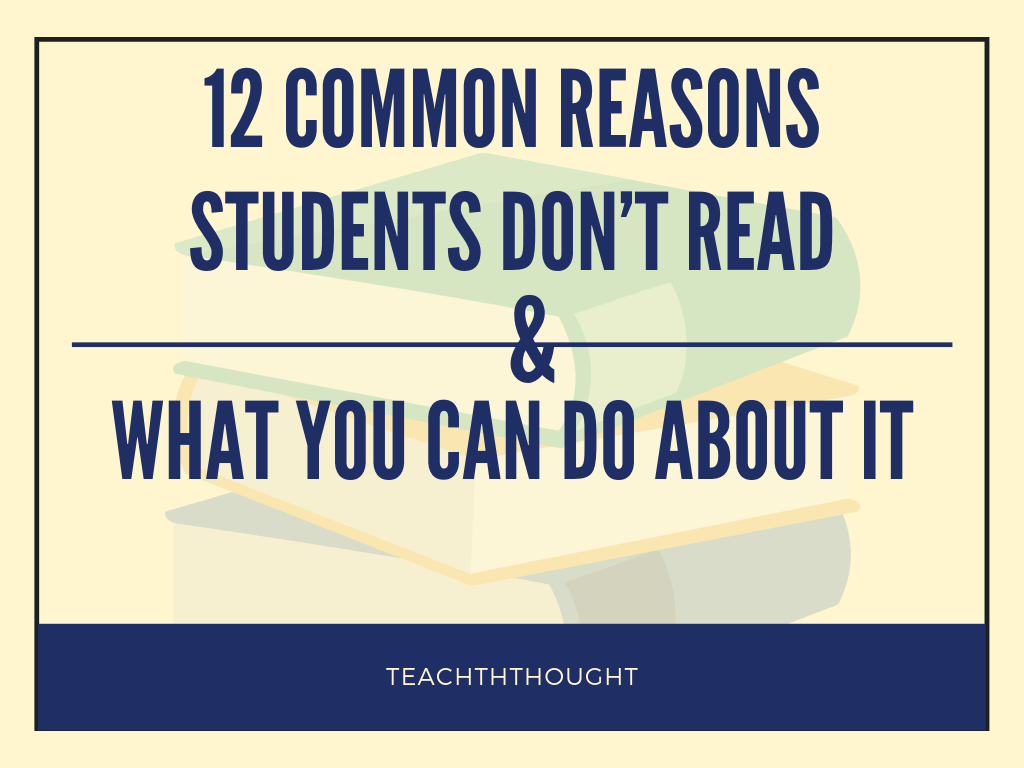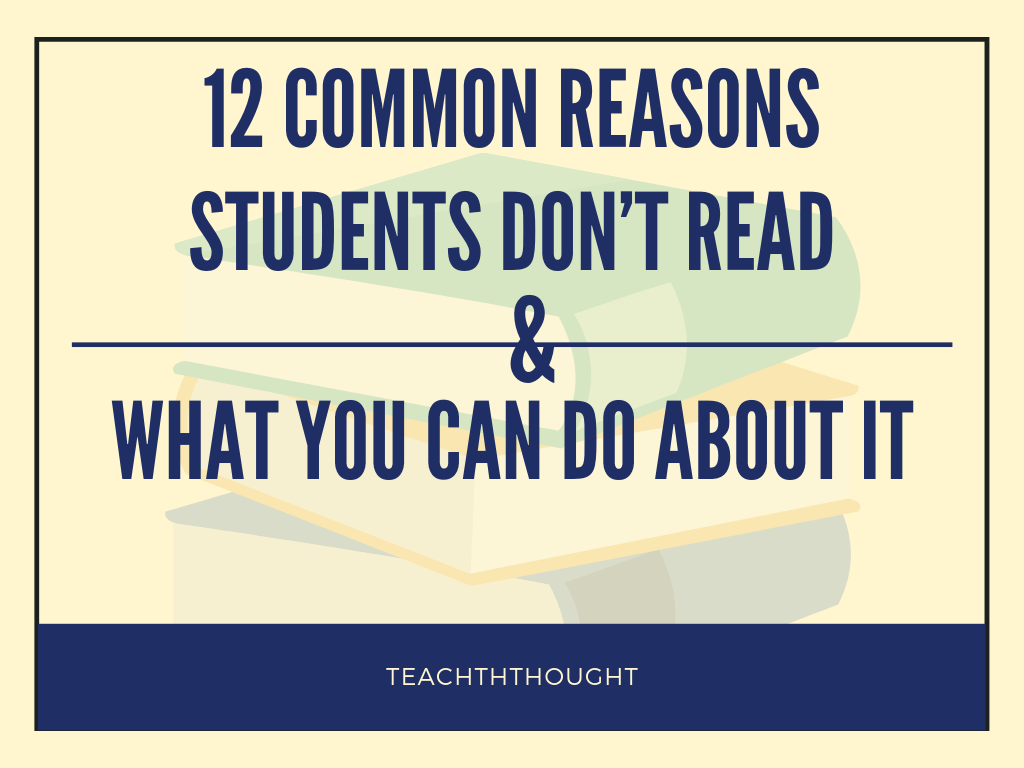 12 Common Reasons Students Don’t Read & What You Can Do About It
12 Common Reasons Students Don’t Read & What You Can Do About It
by Terry Heick
Why don’t students read more?
Digital distractions? No books at home? Too much testing? Kim Kardashian? It depends on the student. It depends on illiteracy vs aliteracy. It depends on how you define reading (does reading long-winded character dialogues in Square Enix games count?) So below, I’ve gathered some of the most common reasons students don’t read and provided some ways you can begin to address that issue.
12 Common Reasons Students Don’t Read & What You Can Do About It
1. They haven’t found the right book or type of book.
How do you feel when your principal drops a book in your lap–something well-intentioned but not even a little naturally interesting to you? Do you hate to read because you don’t want to read it?
Possible solutions: I tell my students that when I walk into a bookstore of 10,000 books, 9200 of them don’t appeal to me. The upside? That means there are 800 books I’m dying to read. No one hates to read. Some of us are just pickier readers than others. We’ve got a collection of books for students who think they don’t like reading, too.
See also What I Tell Students Who Think They Don’t Like To Read
2. They need general reading strategies they can turn to from time to time.
Possible solutions: See here.
Possible solutions: ‘Market’ reading to them. Take pictures of them reading. Start a ‘Caught Reading’ class instagram feed or #caughtreading hashtag (send it to me and I’ll tweet it). Treat it with the same creativity and passion that marketing agencies successfully market billion-dollar companies.
3. They need specific reading strategies they can self-select from based on context.
Possible solutions: Identify their strengths and areas for growth as a reader, help them self-assess in the same way, then work together with them and their parents to create a set of 4-6 reading strategies from the list above (or other) for them to use flexibly depending on what they’re reading.
4. Reading can be intimidating.
Reading is fun–until it isn’t. Do I understand it? What will be on the test? Am I at grade level? Above? Below? What if I have to read out loud?
Possible solutions: Don’t make them read out loud unless what you’re wanting to assess is oral fluency! Don’t put them on the spot. Don’t ask comprehension questions out loud. Don’t always insist that they ‘read on grade level’ (Feel like reading Shakespeare after a long day, or would you rather go home and plop on the couch and watch ‘Bar Rescue’?)
5. The reading space or ‘vibe’ isn’t right.
Too noisy. Too quiet. Too many distractions. Too warm, too cold–we all have circumstances we like to read in. I can’t read if it’s not completely quiet–anyone talking and I’m done.
Possible solutions: Allow students to use white noise apps. Put white noise on in the classroom (they’ll get used to it). Create reading spaces in your classroom. Ask your librarian/media specialist if they have any ideas. Turn the lights down. Buy bean bags–even for high school students!
6. They need a reason to read.
And you assigning it isn’t enough.
Possible solutions: Make reading social. The process, the reflections, and the outcomes. Help them see the value of both the process of reading (critical thinking), and the outcomes of reading (knowledge). Help them see reading as part of the relationship between the life they have and the life they want to have.
7. They have too much else to do.
It’s hard to read if you have a million things to do. Who wants to “enjoy a good book” when you’ve got 20 pages of homework to do?
Possible solutions: Help them create a personalized reading schedule that works for them based on their life.
8. It’s not a habit.
Reading is a muscle. The more they read, the more they’ll want to read.
Possible solutions: They need an at-home library of ‘stuff’ they want to read. Or the Epic reading app.
9. They have problems with phonemic awareness.
If they struggle with phonemic awareness, reading is going to be like climbing a mountain.
Possible solutions: Apps can’t solve every literacy problem, but they’re great for practice. Here are some elementary reading apps that can help. And some apps for struggling readers.
10. They have a limited sight word vocabulary.
Limited sight word vocabulary means slow reading speed, which reduces comprehension and makes reading not fun.
Possible solutions: Use Knowji. Have fun with Frayer Models. Play Vocab games. But more than anything else, help them build a sense of momentum as readers. Encountering words in context is better than on an index card for long-term retention.
11. They struggle with their own identity as a ‘reader.’
These students see reading as something that you do at school, rather than an opportunity to make meaning, be entertained, be exposed to new ideas, make friends, etc. Someone that engineers is called an engineer. Someone that writes is a writer. Someone that reads? That’s called a student.
12. They need to know all of the incredible things about reading–topics, knowledge, genres, authors, etc.
Possible Solutions: So show them.
12 Common Reasons Students Don’t Read & What You Can Do About It; image attribution flickr user eugenekim

